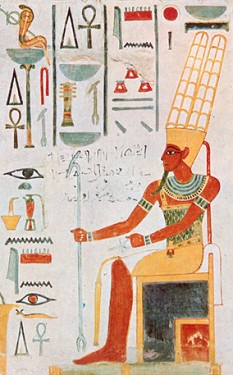
God whose name means 'the hidden one'. He was probably originally a god of the air, and despite his much more important position later, that is what he basically remained. Air is one of life's primary necessities and texts from the New Kingdom thus call him 'Lord of the Breath of Life'. The god first appears during the Middle Kingdom in Thebes, where he quickly superceded the god Montu. Although a number of kings of the 11th Dynasty were still called Mentuhetep (Montu is satisfied), by the 12th Dynasty Amenemhat ('Amun goes in front') had become a popular king's name. In Thebes, Amun formed a triad with Mut and Khons. As this city grew in political importance, so too did the position of Amun. As the god of the capital city he became the king of the gods (in Egyptian Imen-Ra nesut netjeru, later rendered Amonrasonther). From an early stage, Amun formed links with important gods from other places, such as Re, the god of Heliopolis, thus forming Amun-Re and appearing as such in many texts and representations. There were also links with Ptah of Memphis. Hymns from the New Kingdom praise the trio Amun, Re and Ptah: 'Three are all the gods, Amun, Re and Ptah, their equal does not exist'. At the end of the Ramesside Period, when the power of the king was waning, a divine state was created in Thebes with Amun at its head. Numerous decrees to do with life and death, people and gods were issued by him. Only once, and then for a very short time, was Amun deprived of his power - by Amenhotep IV / Akhenaten, who introduced the cult of the Aten and persecuted all other gods, particularly Amun. The god Amun is also known as a member of the Ogdoad of Hermopolis. Together with his female counterpart, Amaunet (who occasionally takes over the role of Amun's consort in Thebes from Mut), he represents the primeval element of what is hidden in darkness. Once Amun had been 'introduced' in Thebes, priestly speculations created a leading position for Amun within the Ogdoad, which quickly resulted in Amun being regarded as the chief god of the eight; the eight were explained as the shape that Amun had assumed. Thus Amun was the begetter of the Ogdoad of which he was himself a part, a typically Egyptian 'aspective' way of looking at things. Amun is usually depicted as a man with a headdress with two tall feathers and a ribbon hanging down his back. His skin is often coloured blue. In as far as he is linked with the god Min, who wears the same headdress, Amun is depicted ithyphallically, with a flagellum suspended over his raised arm. The animals sacred to Amun were the ram and the goose.